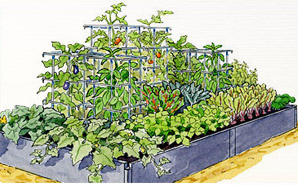
Planning Your Vegetable Garden

Good planning is essential to a successful vegetable garden. Vegetables have specific requirements, and you must choose your site carefully to ensure a bountiful harvest. Here are the basics you need to consider before you select your seeds. (Martha's vegetable garden at her home in Bedford, New York, is at left.)
Experiment with bed designs and plant placement. If your garden beds are already in place, simply set up your garden's template in the Vegetable Garden Planner and start plugging in plants. The vegetables and herbs have already been coded with space requirements, so you can quickly see how many will fit in a given bed or row. Or, use the Garden Planner to design new beds for any garden.
Find Frost Dates
Get a personalized planting chart. Once your plan is complete the software compiles a chart showing how many of each plant you need to buy or raise from seed, the correct spacing and recommended planting dates for your area. You can print both the plan and plant list as a handy reference to take into your garden.
Plan succession sowings. If you plan to grow fall carrots after spring peas, or plant fall garlic in the same space used for summer snap beans, you can incorporate end dates for certain plantings into your plan. The plan will then show available space for a second crop.
Plan crop rotations. Plants are coded according to the botanical family to which they belong, and the Garden Planner keeps track of what you have grown where. When you plan next year's garden based on this year's plan, the Planner will warn you if you try to follow tomatoes with potatoes, squash with pumpkins, or otherwise violate standard rotation practices.
Plan cover crop plantings. The Garden Planner includes several common cover crop varieties for improving soil.